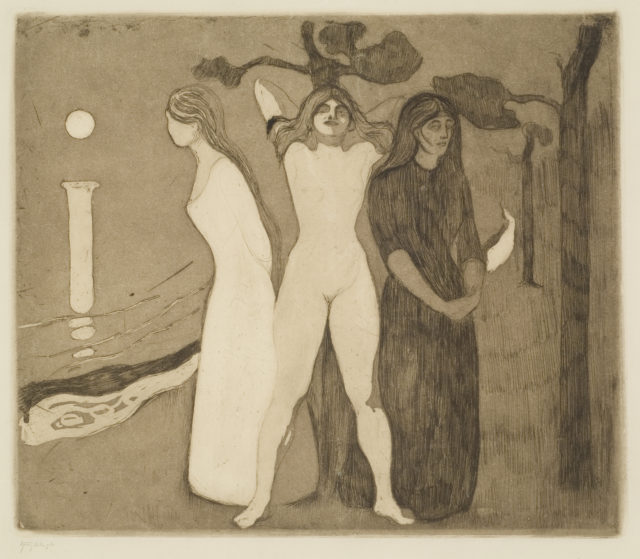Woman 2 (The Woman in Three Stages), undated, etching and aquatint, Gallery Purchase Fund, Parke-Bernet
In this installment of Seen From Storage, I have chosen an undated Edvard Munch etching, as Munch has been one of my favorite artists ever since taking Professor Larry Ligo’s Modern art class my sophomore year. However, before going into the meaning behind this specific work in our collection, it is important to understand Munch’s incredibly tumultuous personal life.
Munch was born in 1863 outside of Oslo (then Kristiania) in Norway, and eventually the Munch family moved into the city when Edvard was one, along with his four siblings. However, at the young age of five he experienced two devastating deaths in his family, losing his mother, sister, and aunt to tuberculosis within the span of ten years. Munch himself dealt with illness as well, having serious episodes of asthmatic bronchitis and fever that brought him close to death.
He enrolled in the Royal School of Art and Design in Kristiania in 1880, thus beginning his prolific career as an expressionist painter. He began exhibiting his work in international shows as early as 1883, with most works expressing themes of tragedy and death, such as 1886’s The Sick Child, which shows the death of his sister. He had multiple affairs with women ending in heartbreak and betrayal, and his relationship with Tulla Larson ended with a bullet wound through his left hand. After suffering from a series of suspected nervous breakdowns, Munch died in 1944 in a suburb of Kristiania. Discovered after his death were 1,008 paintings, 4,443 drawings, 15,391 prints, and an unknown number of woodcuts, etchings, lithographs, and photographs.
Throughout the span of his career, Munch rarely strayed from his traumatic childhood experiences, and his worldview was permanently marked by a tenuous relationship between life and death. Nowadays, it is difficult to think of Munch without thinking of existential themes such as love, heartbreak, pain, death, jealousy, hatred, abandonment, and dread (see: The Scream). He is also very consistent in his use of bleak and melancholic colors and tonalities, and psychological pain is evident in his depictions of men and women in various stages of relationships, with all ending in heartbreak and death.
This specific work, titled Woman 2 (The Woman in Three Stages), is a combination of many different intaglio techniques, including etching, drypoint, aquatint, and open bite. It depicts what Munch believes to be the three essential stages of women – the young innocent virgin in white, the sexually liberated woman in the center, and the older woman in black slowly inching towards death. In the water behind them, the moon reflects as a form of a phallus. Today we understand this to be a simplistic and misogynistic understanding of women, but for Munch, his relationship with women was complicated by insecurity, fear, violence, and tragic death. After losing two of the most important women in his life at such a young age, it left Munch without a firm understanding of gendered relationships, and he often felt inadequate in terms of his own masculinity. If anything, this print should be a glimpse into the psyche of Munch himself, unable to understand females, all the while trying to understand what that meant for his own masculinity. This type of gendered anxiety is an interesting take on more contemporary conversations regarding the differences between gender and sex, and how members of the opposite sex are expected in interact with each other.
For more information on Munch, I would recommend looking at the Munch Museum in Oslo’s detailed account of his life and work in addition to this link highlighting his specific work in printmaking.

